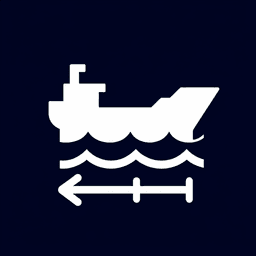
Hull Draught: Definition and Examples in Maritime Glossary
February 27, 2025
Glossary Entry: Hull Draught
Definition: Hull draught, also known as draft, refers to the vertical distance between the waterline and the bottom of a ship's hull (keel). It is a critical measurement for sailors and maritime professionals as it determines the minimum depth of water a vessel can safely navigate.
Importance in Maritime Navigation: Understanding a vessel's hull draught is essential for safe navigation, especially in shallow waters. It helps in avoiding groundings and ensures that the ship can pass through channels, harbors, and under bridges without incident.
Factors Affecting Hull Draught: The draught of a ship can vary based on several factors, including the vessel's load, water density, and sea conditions. A fully loaded ship will have a greater draught compared to when it is empty.
Measurement and Markings: Draught is typically measured in meters or feet and is marked on the hull of the ship. These markings, known as draught marks, are located at the bow, stern, and amidships, allowing for accurate readings from different points on the vessel.
Relevance to Ship Design: The draught is a key consideration in ship design, influencing the vessel's stability, speed, and fuel efficiency. Designers must balance draught with other factors such as beam and length to optimize performance.
Regulatory Considerations: Many ports and waterways have draught restrictions to prevent accidents and ensure safe passage. Mariners must be aware of these limitations and plan their routes accordingly.
Conclusion: Hull draught is a fundamental concept in maritime operations, affecting navigation, safety, and vessel design. Understanding and managing draught is crucial for efficient and safe maritime travel.
Understanding Hull Draught in Maritime Context
The term hull draught refers to the vertical distance between the waterline and the lowest point of a ship's hull, including any appendages such as propellers or rudders. This measurement is crucial for determining the minimum depth of water a vessel can safely navigate without running aground.
Key Questions About Hull Draught
What does draught mean in nautical terms?
In nautical terms, draught (or draft) is the depth of a vessel's hull below the waterline. It indicates how deep the ship sits in the water, which is essential for ensuring safe passage through various waterways. The draught can vary depending on the ship's load; a fully loaded ship will have a deeper draught.
What is hull draft on a boat?
The hull draft on a boat is the vertical distance from the waterline to the deepest part of the hull. This measurement is critical for understanding how much water a boat needs to float without touching the bottom, which is particularly important in shallow waters.
What is the difference between draught and draft of a ship?
While 'draught' and 'draft' are often used interchangeably, 'draught' is more commonly used in British English. Both terms refer to the same concept: the vertical distance from the waterline to the lowest point of the hull. The draught affects a ship's performance, including its speed and fuel efficiency, as a deeper draught increases water resistance.
What is the difference between draught and depth?
Draught refers to the vertical distance from the waterline to the bottom of the hull, while depth generally refers to the vertical distance from the water's surface to the seabed. Understanding both measurements is crucial for safe navigation and avoiding underwater obstacles.
Importance of Hull Draught
Knowing a vessel's hull draught is vital for maritime operations. It helps in planning routes, especially in shallow or restricted waters, and ensures that the vessel can safely pass under bridges and through locks. Additionally, it plays a role in determining the load capacity and stability of the ship.
For more detailed information, you can refer to resources such as Marine Insight or PredictWind.




